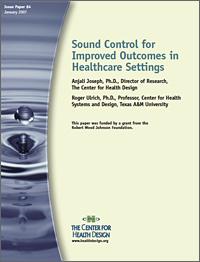Sound Control for Improved Outcomes in Healthcare Settings

Objective: The purpose of this paper is to examine how different aspects of sound-noise, speech privacy, speech intelligibility, and music-impact patient and staff outcomes in healthcare settings and the specific environmental design strategies that can be used to improve the acoustical environment of healthcare settings.
Methods: This paper provides a literature review of peer-reviewed journal articles, research reports, and books published in medicine, psychology, architecture, and acoustics publications. Keywords used to search for articles included noise in hospitals, reverberation, sleep, patient privacy, HIPAA, speech intelligibility, speech security, and music.
Key findings: Hospitals are extremely noisy, and noise levels in most hospitals far exceed recommended guidelines. The high ambient noise levels, as well as peak noise levels in hospitals, have serious impacts on patient and staff outcomes ranging from sleep loss and elevated blood pressure among patients to emotional exhaustion and burnout among staff. Poorly designed acoustical environments can pose a serious threat to patient confidentiality if private conversations between patients and staff or between staff members can be overheard by unintended listeners. At the same time, a poor acoustical environment impedes effective communication between patients and staff and between staff members by rendering speech and auditory signals less intelligible or detectable. This has serious implications for patient safety. A well-designed acoustical environment is critical in addressing these problems related to noise and communication of information. Noise levels can be effectively reduced by providing single-patient bedrooms, installing high-performance sound-absorbing acoustical ceiling tiles, and removing or reducing loud noise sources on hospital units. Also, acoustical ceiling tiles improve speech intelligibility by reducing sound reverberation and increase speech privacy by reducing sound propagation into adjoining areas. Another measure for increasing patient confidentiality is providing private rooms enclosed with walls that go up to the ceiling, thereby preventing voice travel through ceilings in spaces where private patient information is likely to be shared. A large body of research also shows that music therapy is effective in reducing anxiety and distress among patients in many different types of healthcare settings.
Conclusions: Sound control is critically important in healthcare settings, and different environmental design strategies have proven successful in mitigating negative effects of noise while allowing effective yet private verbal communication.


Add comment
Log in to post comments